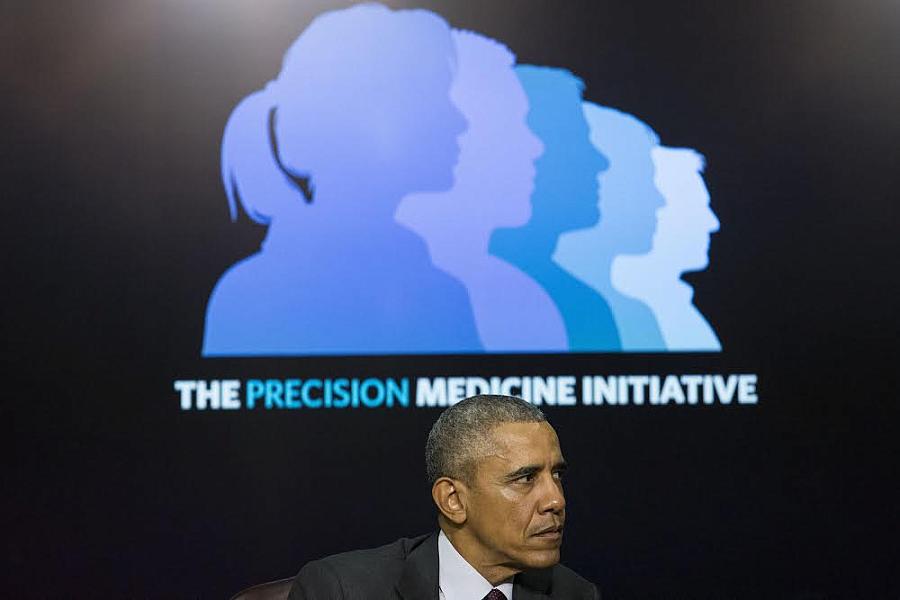Can ‘precision medicine’ help frame the fight against childhood adversity?

Photo: Drew Angerer/Getty Images
Precision medicine has been a growing buzz phrase over the past couple years, and the concept received a big push last year when President Obama announced his Precision Medicine Initiative. Last month, government scientists began recruiting a million volunteers as part of the larger project to understand the interplay between a person’s genes and lifestyle.
The approach seeks to create tailored treatments for patients based on their individual genes, environment and behaviors. While proponents say it has the potential to radically improve treatment of diseases such as cancer and Alzheimer’s, the realization of that promise is still a ways off for most diseases.
Even so, the idea is already percolating into fields in which the medical science has progressed far less than in the case of cancer or even diabetes. That includes the emerging science of childhood adversity and toxic stress, which research has shown to have potentially devastating lifelong impacts on health.
In a “special communication” published in JAMA Pediatrics this week, Dr. Jack Shonkoff, a leading early childhood researcher, argues not only that we need bigger scientific breakthroughs to combat adversity and stress, but that doctors and researchers might better think in terms of precision medicine and tailored treatments to combat adversity. Shonkoff, the director of Harvard’s Center on the Developing Child, writes:
The evolving concept of ‘precision medicine’ reflects a … greater understanding of how environmental effects on gene expression influence disease risk, pathogenic mechanisms, and differential response to treatments. That same scientific thinking is waiting to be leveraged to drive a comparable transformation in how we address the biological consequences of significant adversity in the lives of young children — and how we determine what works best for whom and why.
That suggests a new and different way of thinking about the urgent question of how adversity and stress can be mitigated before they inflict permanent damage on young brains and bodies. Typically, the talk in early childhood circles tends to focus on better interventions, whether they’re modeled on the Abecedarian Project, the Nurse-Family Partnership, Early Head Start or others. Implicit in many such discussions is the idea that if we could just hit upon the right program and scale it to size, we’d be well on our way to diverting young lives from dire futures of academic failure and failing health.
But while many programs can make a difference in young lives, their effects are often small and uneven. That’s part of the reason why Shonkoff has consistently criticized the field for being risk-averse and too small-minded, particularly when so much is at stake in early brain development and chronic disease susceptibility.
But we also know that not all kids react the same to traumatic events. Some kids are “orchids” and others “dandelions,” to borrow the metaphors of Bruce Ellis and W. Thomas Boyce. In other words, some children are innately more vulnerable to stressful events in their environment than others. The corollary to that basic insight is that different children require different types of interventions. One child might benefit from cognitive-behavioral therapy, while another family might need focused job training, so Mom or Dad can find employment and bring stability to a child’s hectic life.
These differences in how kids respond to adversity suggest that the field of epigenetics, which studies changes in how genes are expressed in response to the environment, could eventually help pediatricians offer far more precise treatments, before the stress becomes “toxic.” Shonkoff says efforts to combat such forms of stress would be wise to take a page from the field of infectious disease:
The final line of defense against infection uses effective drugs matched to specific microorganisms and alternative therapeutics for pathogens that are resistant to conventional treatment. In a comparable fashion, effective intervention for a child facing adversity cannot be determined by asking 'what is the most effective program?' but rather 'how can we match effective services to specific causal factors and differential responses to intervention?'
The promise of both precision medicine and epigenetics have yet to be delivered on, even among the diseases that are their main focus, and it’s unclear whether these fields are the untilled beds of future scientific breakthroughs or just inspiring academic metaphors. But either way, the idea that toxic stress and trauma call out for a tailored range of services and treatments seems like a useful corrective to the quest for the “magic” program for vulnerable kids.
**
Related posts
Preschool is important, but years before are crucial
Leading early childhood expert seeks missing breakthroughs
We know toxic stress is damaging to kids, but how do we fight it?

